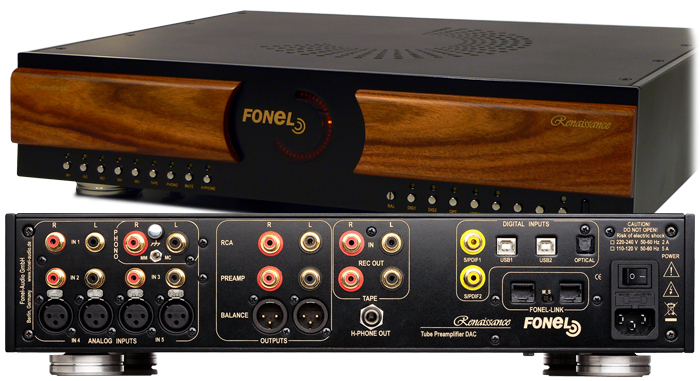This review page is supported in part by the sponsors whose ad banners are displayed below |
 |
 |
Competitors: Against my tubed ModWright LS100 and Fonel's valved Renaissance in for review, an unexpected picture emerges. Made in the US in a luxury chassis machined in Canada, the $4.395 Modwright offers extra i/o socketry, a headphone port, balance and remote control. Via the upgrade slot the user may add a tube phono stage or a forthcoming 24/192 USB/coax digital-to-analog converter. Let's remember that the Reference 2 sells for $11.500.
|
 |
Designed in the Ukraine and built in Germany, the €6.495 Fonel expands in analog i/o ports over the Raysonic as well and includes MM/MC phono. Then it adds a 24/192 DAC with five inputs including two asynchronous USB. To top it off there's a headphone output, balance and remote control and a choice of four wood species for the cosmetic trim and remote wand.
|
|
|
For once Raysonic's made in the PRC confers no pricing advantages but costs dearly extra. What's more, against these admittedly buff competitors the Reference 2 strips back functionality to a surprising degree. Raysonic's gravest omission is the lack of remote. Even the $2.000 US-built Wyred4Sound STP-SE gets a very comprehensive one whilst operating not the ubiquitous motorized Alps pot but a discrete relay-switched array of costly precision resistors. I personally find it nearly impossible to conceive of a preamp buyer in 2011 who'd spent 10 large without remote control at least over volume. For many this omission with the Reference 2 could be the unrecoverable deal breaker. It would be for me.
|
 |
To scuttle this line of inquiry by the prosecution, the defense—let's simply imagine it—now cites the potential slam dunk argument of jack of all trades/master of none. If you've read my ModWright review you already know that its 6SN7 powered 5AR5 rectified headphone socket competed on the level with my $3.995 fully tricked-out Woo Audio Model 5 dedicated headphone amp. Here Jack wouldn't hit jack. Citing superiority of its true balanced circuit next, the defense would quickly learn that the Fonel too runs a no-feedback balanced circuit and runs theirs off three toroidal power transformers no less.
In the end it's about subjective performance of course. But no responsible assessment of the Reference 2 could fail to comment also on competitive context. Here the Canadian comes up well short on featurization and—so one should feel compelled to believe prior to any audition—also value*. From Audio Research to conrad-johnson, from BAT to Rogue Audio, from VTL to Octave, today's choices in valve preamps span the gamut. Here Steven Leung's choices for his top preamp would appear spartan. Hard-core aesthetes translate that to purist of course but battling an Emmanuel Go of First Sound Audio on that front would still seem overly ambitious for Raysonic. The brand's perception was established on value after all. If the Reference products turn their backs on value, it would seem to invite an unnecessary uphill struggle. Present trends force most other companies to offer more for less just to remain viable.
______________________________
* Raysonic does pay Canadian labor rates for its Canadian staff of engineers and office personnel. The offshore labor advantage thus applies only to the machine shop and assembly line.
|
|
|
Worrying about that isn't my business of course. Sonic competitiveness is.
|
 |
  |
 |